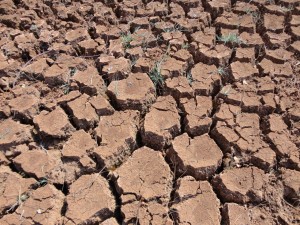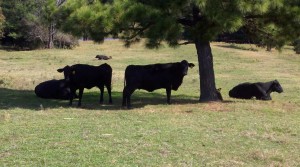Touring through the sundry landscapes of Texas I am reminded of the vast topography under human influence. From beautiful rolling hills, creeks, lakes, forests, and farmland; there is such an incredible abundance of possibility. But, in the coming years, Texas will need to take a keen look at its resource management and find ways to manage holistically, or risk betting the farm.
While tumbling over the vast open plains of Texas it becomes more and more evident that our potential for abundance is all but unlimited. Texas ranchers are no stranger to acreage. Some of the largest ranches in Texas range in the hundreds of thousands of acres.* As the largest state in the contiguous United States, it should come as no surprise that land, BIG land, is a big part of what makes Texas, Texas. And BIG land means BIG potential.
Gun Slingin’ Cowboys
But it’s more than just the land… it’s how we use it. Texas takes pride in the use of its wide open spaces for agriculture and cattle ranching. It’s a tradition that percolates through every element of the culture and even is the butt of much stereotyping. I recall envisioning, when I was only 8 years old, moving from the wild expanses of Northern Idaho to the Deep South of Houston, Texas, tough cowboys riding horses with lassos, spurs, ten gallon hats and a six shooter on their hip. Those childish fancies quickly dissolved as the realities of the big modern city began to set in. But the underpinnings of Texas culture still eventually rose to the surface as I became more aware of her history and social dynamics.
Could it be that the very culture that is so identifiable to Texas is something that threatens how we live on this planet? By even suggesting the idea I risk being sent to the gallows if I can’t provide a strong argument to back up my “fightin’ werds”. Before I disassociate the wayward rancher who might have stumbled upon these words without context, I should qualify what I’m really trying to say.
Unlike the common urban dweller who might approach this subject from an idealogical standpoint or might believe that cattle are somehow unnatural and/or damaging our environment, I am not a vegetarian with a liberal agenda who wants to preach about my moral fortitudes. On the contrary… Not only do I eat beef… I think that the cattle industry has the potential to actually improve the environment, even while increasing stock rates and revenues for ranchers! Sound crazy? It’s actually backed up with some solid science, and a bit of down home Texas common sense.
Cows Don’t Control The Climate!
So, if cattle aren’t the issue, what gives? Well, cattle really aren’t the issue… in fact, they can be a significant part of the solution. The trick is how we manage them. Current management practices are resulting in ever decreasing soil and water qualities, degraded landscapes and erosion, all of which further contribute to the drought and flood pendulum swings we tend to experience in Texas. The summer of 2011 was proof that everything really is bigger in Texas… even the droughts!
What is it about our current management systems that could be contributing to this roller coaster weather pattern? In fact, what’s the connection? Cows don’t control the weather!
It’s true, cows don’t control the weather, but they do have an influence on how the weather impacts our landscape. It’s all in the management. The hooves, manure and grazing habits of these beautiful beasts can all contribute to rich humic soils and a healthy hydrological cycle that retains water through droughts and dry spells or they can cause much of the alarming conditions we commonly see in range land around the state.
Brittle to Humid
It’s not just Texas, the story is the same almost anywhere large range animals are maintained. But what makes the difference between restorative management practices and their deleterious counterpart?
To answer this complex question, we first have to look the links between animal behavior and how it impacts the land. According to Allen Savory, the pioneer of Holistic Management, our pastures are simultaneously over grazed and over rested. Sounds like a silly notion, doesn’t it? In his book Holistic Management: A New Framework for Decision Making, he argues that in more brittle environments, such as we have here in much of Texas, large range animals are an important element to ecosystem health.
Savory utilizes a “brittleness scale” to measure and assess landscapes. On one end of the scale, you have the very humid environments that are common to much of Europe, the Pacific northwest and many other regions of the world. On the other end of the scale, we have the very brittle environments typified by wind eroded desert landscapes. Most of Texas lies somewhere in between these two extremes. On the brittle end of the scale toward the west, and increasingly becoming more humid as you move east across the state.
The Impact of Rest
This is an important consideration when thinking about animal management for several reasons. One important reason is the effect of rest on the landscape. In humid environments, one of the quickest ways to recover ecological health and vitality is to rest the land. Simply removing animals and other forms of human impact for a short period of time gives natural succession the opportunity to spring into action. Plants take over bare soils and natural soil biology kicks into gear and begins cycling nutrients very quickly.
It should be noted at this point that the distinguishing factors between a humid and non-humid environment are as much related to the evaporation rate as it is to precipitation. Brittle environments, for example, may receive significant average annual rainfall but have an accompanying high rate of evaporation. The result is an environment that, for all its rainfall, appears dry and tends to have a brittle “crunch” to the soils and the vegetation.
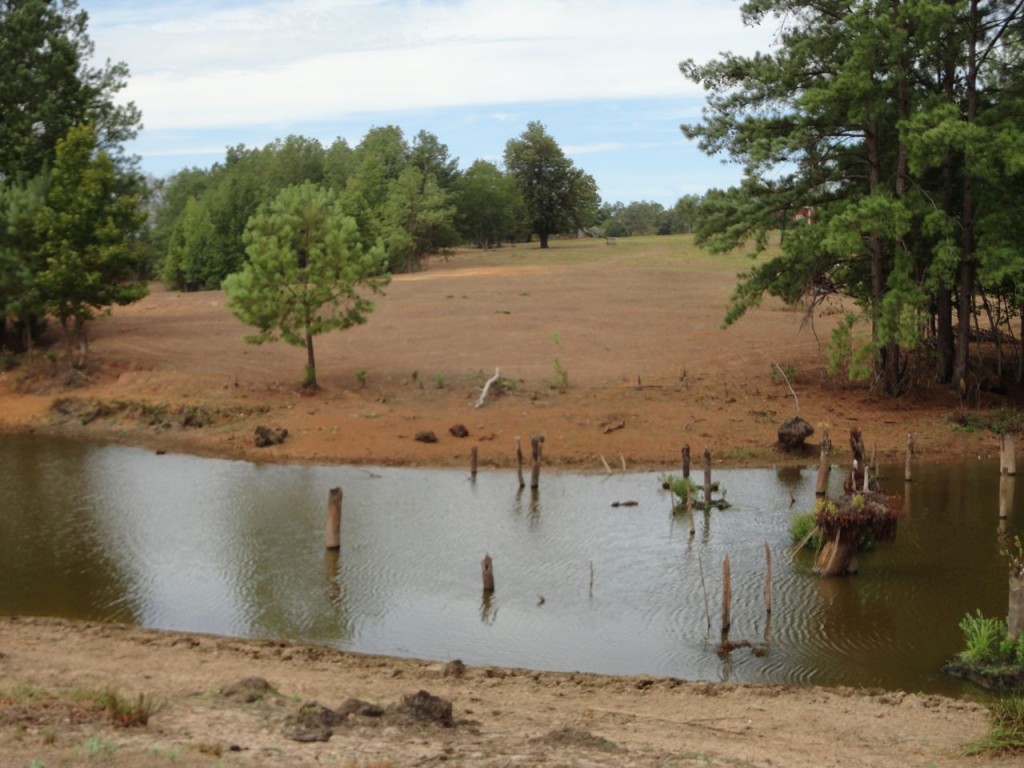
Brittleness is not measured by the amount of precipitation but the precipitation versus the evaporation.
At the soil level, the distinction between humid and brittle is very important and can help you define an appropriate strategy for management.
In humid environments, moist soils promote the growth of a huge verity of micro-organisms that have a veracious appetite. As grasses progress through their growth cycles, dead materials are quickly consumed by these microscopic grazers and returned to the rich soils soon to reassemble into an ever increasing layer of vegetation. As long as nothing stands in the way of this cycle, the landscape has a high likelihood of maturing into a forest. In these environments… it doesn’t take much to maintain healthy soils and healthy animal populations… a little bit of rest goes a long way. It’s actually more of a challenge to keep the successional spring in check and prevent a forest from cropping up in your pasture.

In brittle environments, the desert tends to impede on land through a series of positive feedback loops. The distance between plants increase and the soil bakes, making it harder for new plants to establish.
There likely aren’t very many places in Texas where you would have to worry about the forest impeding upon your grassland. If fact, you might be more worried about the ever encroaching desert. Here, the environment is more brittle and, resting the land can be more detrimental than we might expect.
This is partly because the environment for soil micro-organisms is not nearly as fertile. Without moisture, there is a lack of soil life to break down the dying leaves of grass. Left undisturbed, these grass leaves can only break down chemically, through oxidation, and accumulate to the degree that the dead grass begins to choke out the living grass. In this way, rest tends to slowly kill perennial grass species and extend the desert. What do cows have to do with it?
It’s in The Rumen
The answer is in the rumen. Strange as it may sound, ruminant animals serve one of the most ecologically important functions within these more brittle environments. And it’s quite literally within the rumen itself, where a moist and warm environment breeds a legion of veracious bacteria that quickly reduce dead grass into… soil? Well, that and vital animal proteins. The rumen, in essence, is a walking soil incubator with beef as a byproduct.
Cows eat the tops of the grass, removing the dead and dying material and helping to open the growing tips of the grass clumps to sun and air so they can spring back to life when the conditions are favorable, and then return that material, pre-processed and imbued with an abundance of micro-organisms, back to the soil layers where it can again cycle back into healthy green grass.
If cows and other ruminant animals are doing a service in these brittle environments, why are our Texas pastures still degrading over time? It’s because we do not manage our animals in the same way as nature did on the once expansive open prairies.
The Behavioral Difference
Before we began erecting fences across the great Texas plains, the buffalo and other large game traveled great distances in massive herds. It would be hard to estimate, but it is likely the buffalo population was even greater than the current population of cattle in many areas. But the buffalo, expressing their natural habits and behaviors, were actually contributing to the health of the larger ecology they inhabited. Prairie soils are one of the deepest and richest soils of all land types.
No matter how you look at it, the domestic cow no longer lives by the same rules as the bison of old. So let us look at these differences and see if we can identify any of the contributing factors in land degradation.
We’ve already discovered that removing the ruminant animals from the dryer landscapes has a detrimental effect to both soils and the grasses that evolved in tandem with them. Thus, reducing stock rates isn’t a long term answer to deteriorating pastures. But all the evidence points to overgrazed pastures! If the animals are obviously overgrazing but resting the land isn’t the answer… what do we do?
Calm down… lets think about this rationally. What behaviors, that are no longer being expressed in our domestic herds, did the buffalo exhibit that prevented overgrazing?
Even The Cow Knows Not To…
Allen Savory suggests a whole string of behaviors that result from large game herds’ response to the threat of predation. Recall those old National Geographic documentaries of Africa’s Serengeti, what are the gazelles’ and wildebeest’s response to all the large predators? Strength in numbers. The individuals of a tightly bunched herd are much more secure than a dispersed and docile herd.
Now, there is no way he could be suggesting that this dense trampling behavior could actually beneficial to the eco-system… could he? Nothing good could come out of this trampling intensity… could it? Well, if it is maintained over a long time, no. The modern feedlot shows examples of what happens when this density is maintained in one small area without relent. So what keeps this behavior from becoming like that of the feedlot?
The answer is, just as no animal particularly cares to be preyed upon, no animal prefers to have to eat where they shit. Even the most docile animal would never choose life in a feedlot! The result is that the large herds move quickly through the landscape, eat only what they like, push over, trample and all but destroy the remaining vegetation. Wait, Tell me again how that behavior is helpful? Well, simply stated, they create all this disturbance and, before they have the opportunity to cause any real long term damage, they move on.
It’s All About Timing
The key is in the timing. In his book, Holistic Management: A New Framework For Decision Making, Savory relates an anecdote to help us understand how this timing works and why it’s important.
Suppose you have a small house on a hill and you and your donkey fetch water daily from the stream below. After one year of trampling the same path day after day a substantial gully forms and the stream bank where you load the water cans becomes a trampled-out bog. In this instance you could say that we had had 365 donkey-days of trampling. For thousands of years we observed such damage and in essence said that we had too many donkeys.
Now, suppose you took a herd of 365 donkeys down the hill and hauled a year’s worth of water in one morning. In this instance, you would again have 365 donkey-days of trampling. Though a passersby that afternoon would remark on severe trailing and trampling of the stream bank, those “wounds” would have 364 days of plant growth and root development to heal before you had to come back. When you did, you could expect to find both the trail and the loading place completely overrun by new growth. In fact both might well be greener and healthier than before with the old grass removed and the dung and urine deposited, though they had still borne 365 donkey-days of traffic per year. Thus, time, rather than animal numbers, was the critical factor in trampling.
This example helps illuminate the difference between the behavior of ancient buffalo and that of the docile and domesticated cow. The untold eons of the migration habits of grazing animals under pressure from predation and the drive to constantly move away from their own effluence has created plant species that benefit from this intense but short lived disturbance pattern. Today, with most the natural predators removed, domestic animal habits do not reflect those same behaviors and do not provide the same benefits to the ecology. Cattle today range freely within inclosed spaces with the opportunity to constantly eat and trample an area day after day with no motivation to move on, similar to the first donkey example above. These behaviors are a cause of the overgrazing patterns all to familiar on Texas pastures.
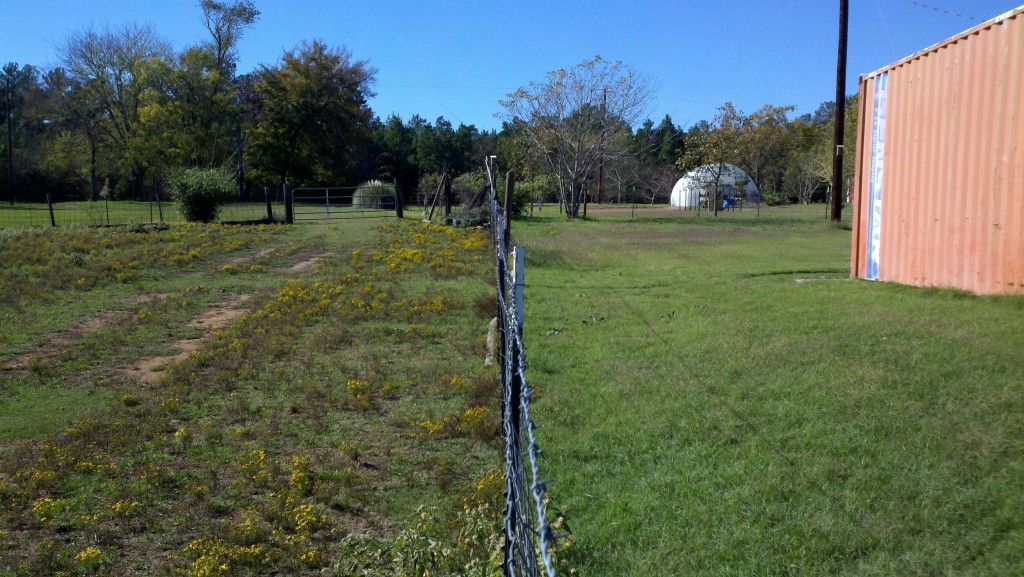
A fence line can tell you a lot about the management of different landscapes. On the right side of the photo is mowed perennial grasses that have adapted to a low growing habit. On the left, pasture land that has been under constant pressure from range animals. Over grazing the grasses while avoiding the woody forbes.
The Holistic Goal and The Saber-Toothed Tiger
Of course, I’m not suggesting that the solution is to import lions or bring back the saber-toothed tiger, nor am I suggesting we need to create stressful situations for the animals such as being stalked by a giant cat. Now that we’ve identified a pattern of behavior that can be beneficial to our landscapes we need only to find a means of replicating that pattern in a way that is both good for the land, good for the animals and best fits our goals… and this is where Holistic Management really shines.
You see, Allen suggests that it is not simply about the various animals, environment, technology and resources within our system. More importantly, he writes, it’s about the goals we set for ourselves and our land. I bet most ranchers have the goal of being able to continually improve their operation, their land, and their margins. To stave off drought and leave the land better off than they found it so their kids can have the same or greater opportunities.
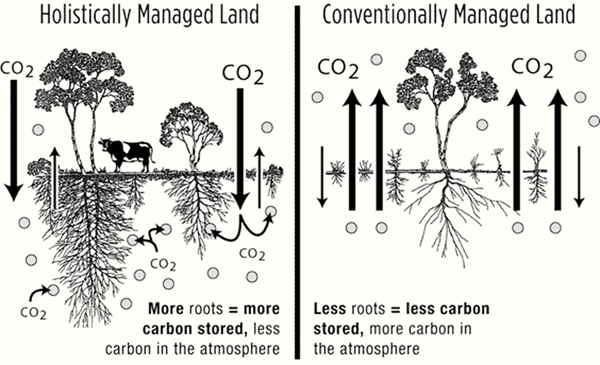 This all sounds great, but what about the nuts and bolts of how it works? Well, my personal exploration of Holistic Management has only just begun and to answer that question, you’ll have to pick up the book and read it for yourself. The solutions are different for every environment and every set of goals… the important thing is to develop a keen eye for observation, a sense of the quality of life you truly what to create for yourself and, as Savory himself so aptly puts it, the assumption that every decision you make within the complexity of organic systems is wrong (or, at least, remember exercise a healthy sense of skepticism).
This all sounds great, but what about the nuts and bolts of how it works? Well, my personal exploration of Holistic Management has only just begun and to answer that question, you’ll have to pick up the book and read it for yourself. The solutions are different for every environment and every set of goals… the important thing is to develop a keen eye for observation, a sense of the quality of life you truly what to create for yourself and, as Savory himself so aptly puts it, the assumption that every decision you make within the complexity of organic systems is wrong (or, at least, remember exercise a healthy sense of skepticism).
*http://en.wikipedia.org/wiki/King_Ranch


